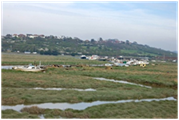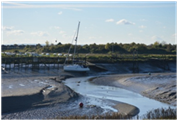It was autumn and our sailing for the season this year was over early. I had decided that I would move Othona, my wood Folkboat, to a mud berth for the winter. I had re-varnished the hull that spring and wanted to avoid any drying of the hull over winter which could cause the planks to open up.
A perennial problem with all wood hulled boats is their preponderance to dry out when out of the water which causes the planks to shrink along their width. On a carvel hull caulking can fall out and of course this risks the boat leaking like a sieve when put back in the water. The classic way of avoiding this problem was to fill the bilge with sea water and lay towelling internally up the sides of the hull to act as a wick. This works reasonably well requiring merely the purchase of a lot of cheap towels! Even so, particularly when exposed to cold winter winds, the hull still dries but less so when lying in mud.
Now mud is not in short supply around the Thames estuary and to the south east of Benfleet Creek Club, on Canvey Island, there were dozens of small drying channels that, at the Equinox, even a long keel yacht could wriggle up and be left safely for the winter. A few weeks earlier I had picked my spot and laid out mooring irons, essential as the Thames is susceptible to tidal surges usually caused by Spring tides coinciding with a strong easterly. This combination could potentially float Othona high enough for her to be dragged across the mud and deposited randomly and at worst dump her on hard ground to the West.
But to get Othona to this location meant moving her at the Equinox and this year that occurred on a Friday; I needed to take a day off work as did Chrissy. So late one September morning we set off from our home in Harpenden to drive to Benfleet wary as ever of it being a Friday, and needing to drive a north about crescent route to the opposite side of London via the M25. But our luck was in and we arrived at the club yard around lunchtime in ample time to move Othona at the top of the tide. All was prepared as I had removed all our kit the week before so we decided to lunch at the clubhouse before taking the club dinghy down to Othona. We needed the club dinghy as I had previously removed our inflatable for some patch repairs. Lunch done we hauled the heavy wood built, clinker dinghy to the slip and rowing against the now flooding creek we slipped downstream; so much easier in a proper rowing boat compared to our inflatable. Reaching Othona I handed Chrissy up onto the deck and then passed up a flask of tea and nibbles we had provisioned to keep us going together with some spare rope we would use for securing the boat on her mud berth.
Now there is a big difference between the stability of an inflatable and that of a clinker dinghy. You can stand on the tubes of an inflatable and as long as it’s firmly tied to the boat you are boarding it will support some of your weight. The same cannot be said of a clinker dinghy and I had forgotten that essential difference. Placing my foot on the edge of the dinghy I pushed up to board Othona and with very little hesitation the edge of the dinghy went down. Water cascaded in and I went into the river. The edge of the dinghy smashed into the hull almost removing my head and then promptly flipped up again before settling. Chrissy screamed, I gurgled and I was surprisingly rapidly swept away with the stream. And I with no lifejacket, fully clothed and wearing boots.
Luckily one of the ropes we had brought along was now floating in the water and I was able to grab this and I shouted to Chrissy to cleat the other end. This should enable me to haul myself back to the boat. It was not far, perhaps the length of two dinghies but I can vouch that it took a surprising amount of effort to pull myself back let alone board Othona. Even with a helping hand to climb back onto Othona with its low freeboard, I struggled, for I dare not board via the dinghy flooded as it was. And once aboard Othona I began to freeze gently in the wind.
Well first things first. I had spotted that one of the dinghy oars had floated away upstream with the incoming tide. We needed that oar and we could see that it was caught on the bank where the spade end had dug into the mud, but it was slowly disappearing with the rising water. The only way to get it was to go back in the water or walk very carefully along the bank and negotiate the slippery mud and rapidly filling creeks. Caution indicated a wet and muddy walk. I set off with my boat hook in hand and, not before time a lifejacket, asking Chrissy to shorten the lines in the meantime as we would need to leave the mooring quite quickly on my return. I splashed and slid my way along the bank until I was able to see the oar, wedged in the mud, down a steep bank. It was beyond reach. Looking around I found some mooring rope attached to a stout wood post and used this to lower myself down the bank where I was able to grab the oar. Success and I wasted no time slipping and sliding my way back to Othona.
The next job was to empty the water from the dinghy so, covered in mud, very cold and dripping with water, I grabbed a bucket and began to bail the dinghy by lowering the bucket down, then lifting and emptying. It took some time but when the dinghy became more stable I was able to get back in and bail from there which was easier and faster. At last, job done and me shivering, we started the engine and slipped from the mooring to wend our way up a small creek nearby to the pre-prepared winter mud mooring. I did not really consider abandoning our plans; perhaps I should have but I was not sure I would get Othona onto the mud berth if I left it another day or two. Anyway no further problems ensued and locking up we clambered back into the dinghy and at the top of the flood made easy progress back to the club slipway. It was late afternoon as we arrived back at the car and luckily no one was around to see me muddy and shivering; they had departed long before.
However I needed to get out of my clothes for I was now seriously cold. My problem was a lack of dry clothing. Chrissy had her sailing jacket but it did not fit and the only dry element of clothing in the car was my pair of après ski boots. However keeping wet clothing on was not a good idea so I stripped down to my wet underpants, although I have to tell you that Chrissy did infer that I drop these as well, and put on the only dry clothing I had, the après ski boots. Sitting in the car as I warmed up from the car heater, sadly no heated seats in my old jalopy, we at last saw the funny side of the incident. As we drove the two hours home I kept to the speed limits as explaining to a police officer why I was only wearing underpants and après ski boots on the M25 on a Friday night in September would not have been straightforward. Lessons learnt? ALWAYS wear a lifejacket.....I was very lucky! Think about what you are about to do before you step into or out of a small dinghy. Keep spare warm clothing on board (or in the car); trousers, jumper, hat, water/wind proof jacket and pants(!) as a minimum. Have a safe, enjoyable, dry and hopefully warm 2022.
Submitted on 11th March 2022


